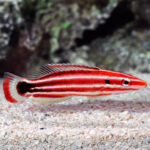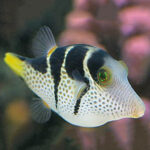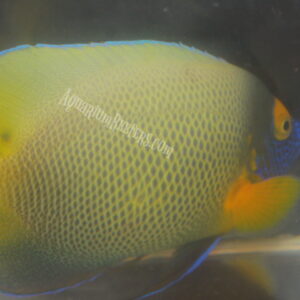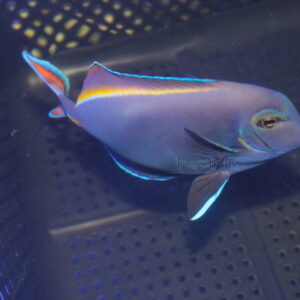Description
The Porcupine Puffer, scientifically known as Diodon holocanthus, is a unique-looking fish with a maximum size of around 20 inches (50 cm). It has a stocky body covered in small, spiky spines. When threatened or stressed, it can inflate its body, making the spines stand erect.
Taxonomy:
The Porcupine Puffer belongs to the family Diodontidae, which includes other species of pufferfish. Its closest relatives are the other members of the Diodon genus. The genus name, Diodon, is derived from the Greek words “di” meaning “two” and “odon” meaning “tooth,” referring to the two large teeth at the front of its mouth. The species name, holocanthus, comes from the Greek words “holos” meaning “whole” and “akantha” meaning “spine,” in reference to the spiny appearance of the fish.
Natural Habitat:
In its natural habitat, the Porcupine Puffer is typically found in coral reefs and rocky areas. It prefers shallow waters with plenty of hiding spots such as caves, crevices, and coral formations. These habitats provide protection and camouflage for the pufferfish.
Keeping the Porcupine Puffer Healthy:
The Porcupine Puffer has a moderate care level and can be somewhat challenging to keep. It requires a spacious aquarium with excellent water quality and proper filtration. A well-established tank with live rock and hiding places is beneficial. Regular monitoring of water parameters, temperature, and salinity is necessary to maintain optimal conditions.
Special Requirements and Feeding:
Porcupine Puffers have powerful jaws and teeth designed for cracking open the shells of their prey. They require a diet that includes hard-shelled crustaceans, mollusks, and other meaty foods. Their diet should also include a variety of frozen or live foods such as shrimp, squid, and clams. Care should be taken to ensure that their diet includes foods that help maintain healthy teeth growth.
How Many Should I Keep:
Porcupine Puffers are best kept singly or in mated pairs due to their territorial nature. They can become aggressive towards other puffers or similar-looking fish.
Natural Defence:
The Porcupine Puffer has a unique natural defence mechanism. When threatened, it can inflate its body by ingesting water, making it appear larger and more intimidating to potential predators. Additionally, its spines provide protection against predators.
Lighting Preference:
The Porcupine Puffer does well under standard aquarium lighting conditions. Providing appropriate lighting can enhance the visibility of their colours and patterns.
Suitable Tank Mates:
Due to their territorial nature and potential aggression towards other fish, Porcupine Puffers are best kept in a species-specific tank. It is generally not recommended to keep them with small, delicate, or slow-moving fish, as they may perceive them as prey.
The Porcupine Puffer, or Diodon holocanthus, is a fascinating fish with a distinctive appearance and unique defence mechanisms. It requires proper care, a suitable diet, and a well-maintained aquarium to thrive. By providing the necessary conditions and understanding its natural behaviours, you can enjoy the captivating presence of the Porcupine Puffer in your aquarium.
Reproduction in the Wild:
Porcupine Puffers reproduce through external fertilization, where the female releases eggs and the male releases sperm into the water column. This process usually occurs during the warmer months when the water temperature is optimal for successful reproduction. Once the eggs are fertilized, they become buoyant and float in the water.
Breeding Diodon holocanthus:
Breeding Porcupine Puffers (Diodon holocanthus) in captivity can be quite challenging. Here’s an overview of the breeding process:
- Set up:
To encourage breeding, a spacious aquarium with appropriate water conditions should be provided. The tank should have hiding places and live rock to simulate their natural habitat.
- Courtship/Spawning:
Courtship behaviours of Porcupine Puffers are not well-documented. In the wild, they likely engage in courtship rituals, such as chasing and displaying their colours to attract mates. Once a pair has formed, the female releases her eggs while the male releases sperm to fertilize them.
- Rearing:
After fertilization, the eggs will hatch into larvae within a few days. The larvae are tiny and require specialized care. They need to be provided with suitable food sources, such as copepods and rotifers, to ensure proper nutrition and growth. Rearing larvae can be challenging due to their small size and specific dietary requirements.
Sexual Dimorphism:
Porcupine Puffers do not exhibit clear sexual dimorphism, meaning it is challenging to visually distinguish between males and females based on their appearance alone.
Distribution:
The Porcupine Puffer, Diodon holocanthus, is naturally distributed in tropical and subtropical waters of the Atlantic Ocean, including the Caribbean Sea, the Gulf of Mexico, and parts of the eastern coast of the United States. It is important to note that while captive-bred and line-bred strains of Porcupine Puffers may be available in the aquarium trade, the original fish species are sourced from their natural distribution areas.
Summary:
The Porcupine Puffer (Diodon holocanthus) is a unique and captivating fish species known for its distinctive appearance and defensive capabilities. They require careful attention to their care needs, including a proper diet and suitable tank setup. While breeding Porcupine Puffers in captivity can be challenging, successful reproduction has been achieved under controlled conditions. Understanding their natural behaviours and providing appropriate conditions can help enthusiasts appreciate the remarkable characteristics of this fascinating fish.
Please note that successful breeding of Porcupine Puffers is rare in captivity, and it is crucial to prioritize the well-being and conservation of wild populations by sourcing fish responsibly from reputable suppliers.
The Fish pictured here are representative only and the livestock you receive may vary in pattern, coloration, and shape.








